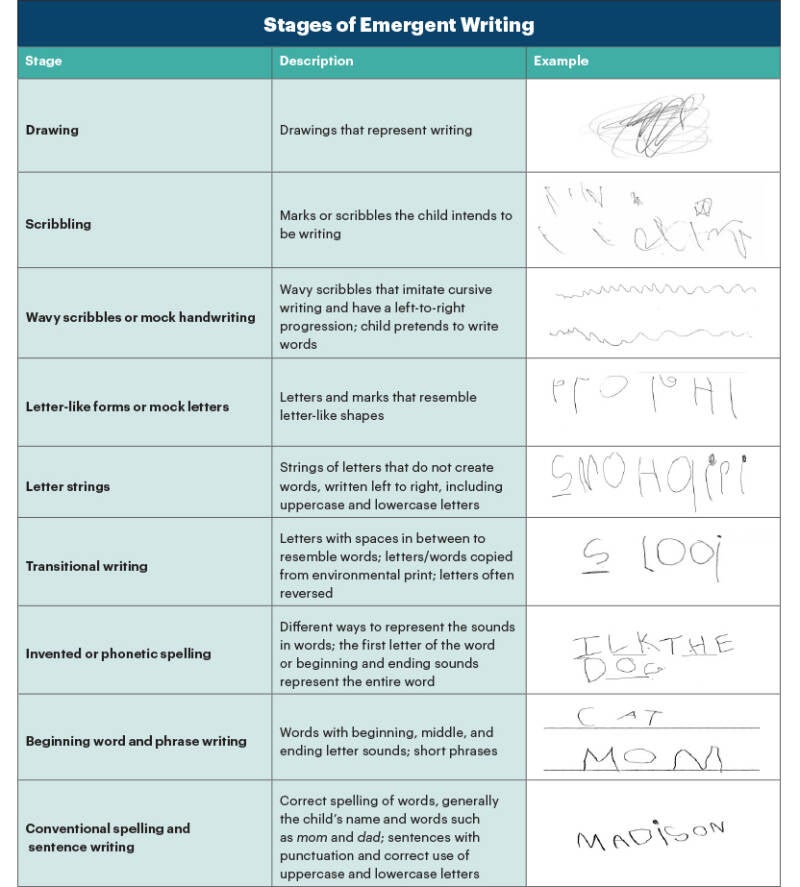Stages of Writing Development

Pre-Literate Stage (0–2 years)
Scribbling and drawing are actually the earliest forms of writing! During this first stage of writing development, children often imitate adults by picking up pencils or crayons and making marks on paper. Through this kind of pretend play, they begin to see themselves as writers.
As children experiment with making lines, shapes, and symbols, they start to understand that their thoughts and ideas can be represented visually and even “read” back later.
Classroom Ideas for the Pre-Literate Stage
One of the most effective ways to support early writing is by observing a child’s scribbles and asking them to explain what they have written. Encourage them to share their story or describe their marks.
Provide easy access to a variety of writing materials—such as crayons, markers, paper, and clipboards—so children can create whenever inspiration strikes. Setting up a dedicated “mark-making area” or “writing corner” in the classroom gives them a special place to explore writing.
Writing simple notes to children is another great strategy. Receiving written messages can inspire them to respond and help them see writing as a meaningful way to communicate.
Emergent Stage (2–4 years)
At this stage, children begin experimenting with letter-like shapes and early attempts at actual letters, though their writing may still appear random or unevenly spaced. Between ages 2 and 4, children start recognizing that the symbols adults use are called letters and that these letters represent meaning. While there’s little connection yet between letters and sounds, children understand that letters are an essential part of writing. As they move from scribbles toward recognizable letters, they begin to see themselves as true writers.
Classroom Ideas for the Emergent Stage
Encourage children to write their names—first by tracing dotted outlines and then by attempting it on their own. Expand this to writing familiar words like “mom,” “dad,” or the names of friends and siblings. You might also have them create name tags, labels, or signs for classroom play areas.
Reading aloud each day is also key. It helps children develop a love for books, sparks imagination, and reinforces the understanding that written words have meaning. Through repeated readings, children begin to recognize familiar words and may even try to write them independently. This process connects reading and writing in powerful ways.
Transitional Stage (4–7 years)
Between ages 4 and 7, children start to link sounds with letters. They move away from using random letters and begin using “invented spelling,” where they represent some of the sounds they hear in words. It’s common for children at this stage to reverse or confuse similar-looking letters—this is a normal part of development. Rather than correcting every mistake, focus on encouraging their progress and providing regular opportunities to write.
Classroom Ideas for the Transitional Stage
Incorporate writing into pretend play—children can make shopping lists, create menus for a make-believe restaurant, or write invitations for a pretend birthday party. You can also involve them in real-life writing experiences, such as making a holiday wish list, writing a letter to a family member, or leaving notes for classmates.
Fluent Stage (5–6 years)
By around ages 5 and 6, children begin to understand that words have conventional spellings. While they may still make phonetic or inventive spelling errors, they are increasingly aware that some words can’t be sounded out and must be memorized (sight words). They also start recognizing that some words have multiple meanings. At this stage, children can begin learning the writing process—drafting ideas first and revising later.
Classroom Ideas for the Fluent Stage
Real-world writing tasks are highly motivating. Activities such as writing letters to a pen-pal, sending notes to friends or family, or even writing to a favorite celebrity give writing a real purpose. Shared writing—where you and the child take turns writing sentences—can be engaging and supportive. If a child prefers to share ideas verbally, you can use dictation to write down their words, showing that their thoughts have value and can be expressed in written form.
The table below from NAEYC.org provides examples and descriptions of each writing stage, outlining what teachers and caregivers can expect at every level of development (Byington, 2017).

Create Your Own Website With Webador